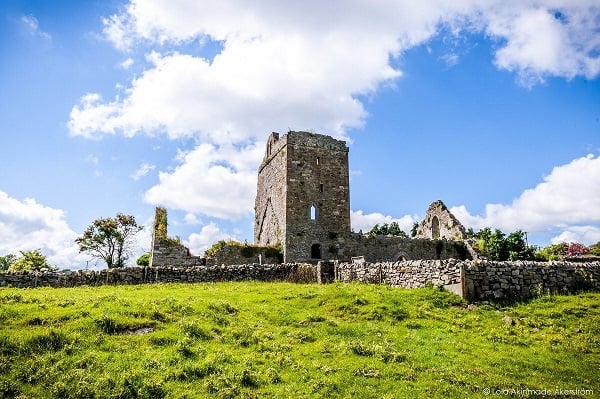
On a recent adventure in the Republic of Ireland, my parents and I stumbled upon one of the greatest spiritual discoveries in all my travels. Let me tell you a story that will end with the most famous saint in all the world.
Spending time in the Kilkenny region is very special to my family because one of our forefathers built the original castle that stood at Kilkenny and his bride Isabella was the driving force behind building the first church there to glorify God. The earl and his wife were not perfect people, but they were God fearing leaders who left an honorable legacy for centuries.
In the rolling hills surrounding this town on the Nore River once stood a village called Newton Jerpoint. It was situated just across the river from a large Abbey that trained men for ministry. Newton Jerpoint existed from about 1200 to around 1600 when all the people living there either left because of attack, or more likely died during a plague. Over the centuries the stones of the abandoned buildings were reused in nearby cities and the footprints of the buildings, roads, mills, taverns and homes were overgrown. Even the church that has stood there since about 1200 was overwhelmed by vines and other shrubs.
In 2005 this land went up for public auction. There was some mention that there could be antiquities on this land, but it wasn’t clear what that might entail.
Joe O’Connell, a recently retired pig farmer, had put in his 50 years of hard work raising livestock, and fancied the manor on the land as his fixer upper retirement home. He and his wife Maeve had raised their children Nicholas and Annabelle and were excited when their bid was accepted, and they moved into the home.
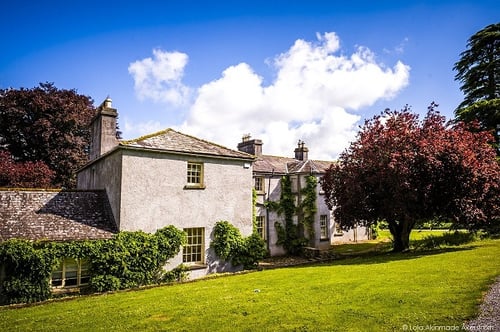
Not long after, the antiquities board came calling to inform Joe that they needed to allow historians and archeologists access to see what might be under the vegetation overgrowth in the pastures where Joe already had sheep grazing along the banks of the river.
Hidden Treasures
When the teams of researchers cut away the vines, trees, vegetation and other growth, they were stunned to find a completely undisturbed town dating to 1600. It is the only one of its kind in all of Europe. Removing the trees and vines exposed the incredible remains of the church and hundreds of grave markers.
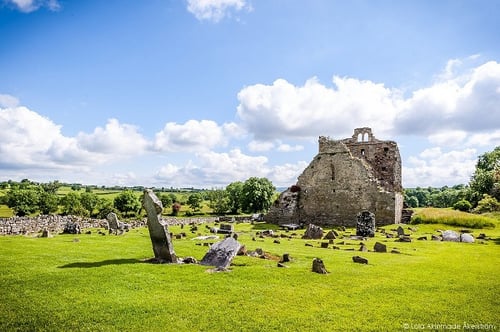
When my parents and I arrived at the O’Connell home for a tour of this property, we had no idea what was waiting for us. We sat with Joe in the barn for 10 or 15 minutes, listening to stories about his sheepdogs and what life is like in southern Ireland. His thick sing-song Irish brogue forced us to listen very carefully to understand what he was saying.
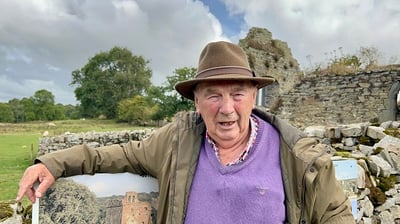
We three were the only ones on the tour, and as we walked over the hill and approached the ruins of the church, Joe pointed out different ornamentation on gravestones and their meaning about the power of Christ to have victory over death, and the hope of heaven.
He walked us into the church, and as soon as we stepped into the nave, I felt something very powerful. I wasn’t sure what it was, but I knew that this was a special place. As we stood where the people would have stood hundreds of years ago, he explained that when people came to church, they never sat down, but would stand and expect the presence and power of God to encounter them. Now I was really listening; I was really fascinated about the history of our faith in this place.
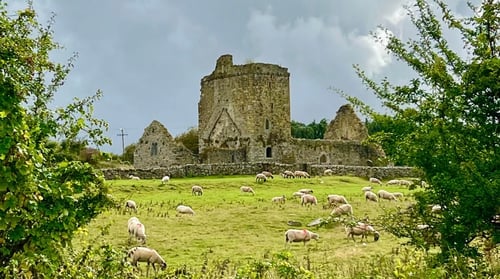
Joe asked me to stand where the priest would stand and raise my hands in blessing. He pointed out many grave markers in the floor of the church, and I tried to imagine what it would be like if the roof was still in place. The walls were still intact – some at least two stories tall, still standing after 800 years! The air felt heavy with meaning. It felt like a holy place that was unspoiled by tourists, gift shops or modern renovations. I wondered if my 26th great grandfather who established the towns here ever worshiped in this church. Surely, he would have known about it here so close to the Abbey.
When Joe took us over to a larger grave marker that was an effigy of a bishop or important church leader, he said,
“Now here’s something that you’ll never forget. Let me tell you the story of who is buried here.”
A Generous Man of Miracles
There once was a man who lived in the Middle East in the 200’s and 300’s. His parents died of a plague while he was young and he inherited their large estate. This man was raised by his parents to love Jesus, and he wanted to obey Jesus’ words:
“Sell what you own and give the money to the poor.”
So, he used his whole inheritance to help the needy, the sick, the suffering. He dedicated his life to God and became a church leader, becoming the bishop of Myra at a young age. He became known throughout the land for his generosity to those in need, his love and care for children, concern for sailors and ships, and even those affected by fires. (Considering what we’ve been through here in Butte County, that got my attention.)
Under the Roman Emperor Diocletian, who ruthlessly persecuted Christians, this bishop was put in prison and suffered greatly. After he was released, he attended the Council of Nicaea in AD 325.
He was a man who walked in the power of God and known for many miracles of calming the sea, bringing freedom to the falsely accused prisoners, and healing the sick. The stories he is most famous for is for caring for those who were unmarried.
There is a story told about him concerning a man with three daughters who was very poor. Without a dowry to give for his daughters, they would be unable to attract suitors to marry so were destined to be slaves, and possibly prostitutes. One night this bishop secretly tossed a bag of gold through the window, and in the morning the father found the gold which he used to marry off his first daughter. The night after the first daughter was married, again he tossed gold through the window, which ended up falling into a sock that was hanging to dry by the fireplace. The second daughter was then happily wed. The night after that wedding the father stayed up all night to catch this anonymous benefactor, and when he saw him, the man made the father promise that he would not tell anyone where these gifts came from.
This bishop died on December 6th 343 AD and within two hundred years, people were making a pilgrimage to celebrate his life and ministry. Quickly he was dubbed a saint by the early church, with December 6th his celebratory feast day.
The Recognition of a Beloved Saint - Who Is He?
For fear that his remains would be desecrated by invaders during the crusades, sailors took the remains of this saint to Italy. In the 1100’s, two knights brought some of the remains to Ireland, which was the end of the known world then, for safe keeping. The Templars were known for collecting relics so this was in keeping with their efforts to squirrel away treasures.
This effigy on Joe’s land shows the heads of the two knights that brought these remains here "peeking" over each shoulder. For the time period, this effigy indicated this was a very important person.
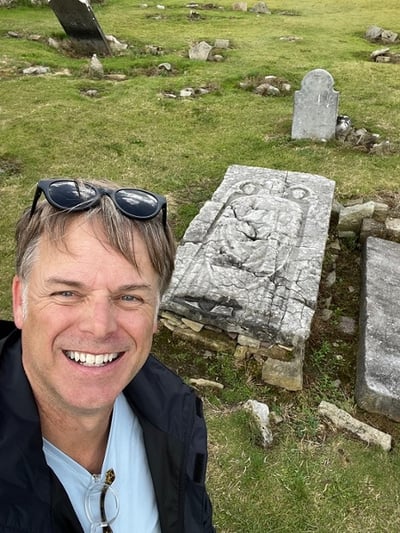
Who is presumed to be buried here in southern Ireland on Joe’s sheep pasture?
It is St. Nicholas of Myra, the one we would associate with Santa Claus.
Now, you might be thinking: Joe’s just spun this tall tale to make a few bucks. However, let me give you just a few reasons to consider that maybe some of the remains of St. Nicholas truly are buried in Ireland on Joe’s property.
- The ordinance survey map of 1839 highlights the tomb of the saint being there.
- The church was called the Church of St. Nicholas, dating back to the 1200’s.
- Joe & Maeve’s wedding anniversary is December 6th – St. Nicholas Feast Day.
- Their son is named Nicholas, who is named after his grandfather and great grandfather.
- Joe wasn’t looking for a second career, and he never fancied himself as a tour guide. He explained that he feels it’s an honor to be a steward of a treasure this beautiful.
Joe remarked,
“They say coincidences are God’s way of staying anonymous, so I firmly believe that his remains are here.”
As for my observations:
- There was a peace and presence of God there that was very sweet and welcoming.
- This is a shepherd, named Joseph, who nobody knows, in a town that doesn’t even exist anymore, off the main highway. This feels like where God would keep something special.
What Does God Want To Reveal to Us?
While we don’t travel to where saints are buried to receive miracles, they are wonderful places of reflection. After walking through the whole of the sheep pasture, along the rushing river and up to the graveyard one last time, I stopped to pray. I prayed and said, "Lord, I don’t know if St. Nicholas is really buried here, but I do know you have met me here, so what do you want me take away from this place?"
I felt the Lord impressing upon my heart:
“I will empower you and I am calling you, into a radical generosity in this next season.”
I prayed and said, “Lord, if you teach me how to walk in this way, I will give whatever you say to give.”
Since returning from Ireland a few months ago and processing this experience, I can’t say for certain that I visited the grave of the real Santa Claus, but I will say that I went to a place where God inspired me to be more aware of the needs around me, more openhanded with what he’s given me and more creative in meeting needs.
I suppose the true spirit of Christmas is found in the generosity of our God – that was reflected in St. Nicholas of Myra, and is still inspiring pilgrims like me today.
May we be courageous in our generosity, believing that our good God will provide for everything we need, and then give us even more to bless others.
I invite you to worship the birth of Jesus with us this Christmas Sunday at 10 a.m. in the Dome.
You can also live stream our service on Facebook and YouTube at 10:00 a.m.
If you missed last Sunday's message, "Emmanuel - God With Us", click here.



